A burned out bulb on your car isn’t just an annoyance, it’s a safety issue… and one that could get you pulled over. So many of my favorite COPS episodes on TV start with a plain old “your tail light is burned out” traffic stop. Bad boys, bad boys… what’cha gonna do?
The main purpose of this article is to provide a list of the LED replacement bulbs for the brake lights, parking lights, stop lights, turn signals, and reverse lights for a Ferrari 512 TR. But even for those of you who don’t drive a 1990s-era Ferrari, and own a car that has standard incandescent bulbs installed, I recommend that you consider swapping your old auto bulbs for LEDs.
Upgrading to LED bulbs makes your car easier to see (and therefore safer to drive) and requires fewer bulb changes over the life of your ownership. In fact, an LED bulb will almost certainly never need to be replaced in your car, even if you own the car for another 40+ years.
So for Ferrari 512 TR owners, this article will tell you the exact bulbs you’ll need to swap yours out. And for owners of other cars, there’s still useful info for you below (make sure you check out the red vs. white bulb photo), and you can click on the included links below to find the right LED bulb for your car.
LED Replacement Bulb Colors
The OEM turn signal bulbs in many cars (including the Ferrari 512 TR) are amber colored, since the law requires them to light up amber if they’re inside a clear lens fixture. So your replacement turn signals should also be amber for the same reason.
But because the tail light and brake light lenses are red, Ferrari (and most other car makers) often use white bulbs in those locations. However, when replacing your tail lights and brake lights with LEDs, I recommend using red bulbs, which will emit light that won’t get filtered out by the red lenses. Here’s a side-by-side comparison of red vs. white LED bulbs behind a red lens:
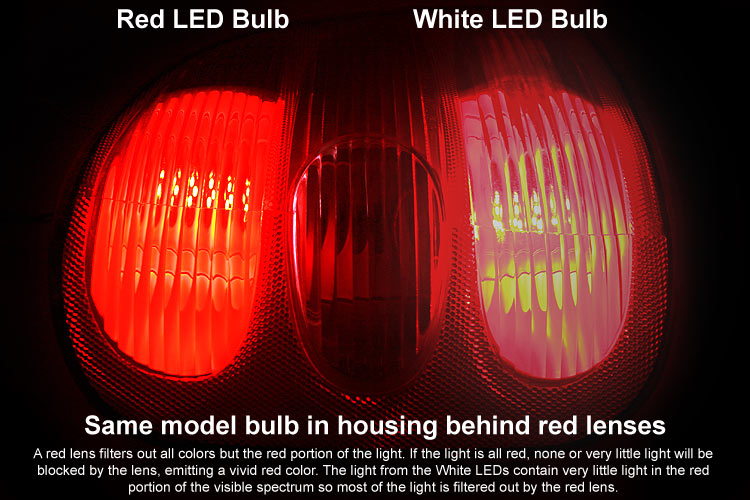
Even if the original bulb is white, use a red LED bulb for best results when replacing tail and brake lights.
As you can see from the photo, a white bulb will work, but a red one will give you much better results. And for turn signals, an amber bulb will work best in either a clear or a yellow-colored fixture.
My Favorite Automobile LED Bulb Brand
As LED bulbs become more popular, more companies are manufacturing them. I’ve used a number of different LED brands over the years for many of my cars, but my currently favorite car LED manufacturer JDM ASTAR (and my favorite place to buy them is Amazon).
If you shop around, you’ll find a wide range in prices for automobile LED replacement bulbs. The first-generation LEDs (which look kind of like Christmas lights) should be avoided. The flat LED emitters are the newer technology, and are the brightest and most reliable. JDM ASTAR makes a wide range bulbs; the ones with the most emitters and extra features (such as lenses and sealed enclosures) are the brightest, but they cost a bit more than their other versions that come with fewer emitters and extra features. The examples I link to (which I purchased for my car), are their “top end” LEDs, but feel free to shop around for the bulb that’s right for you. JDM ASTAR bulbs aren’t the cheapest, but I believe they’re the best value.
Sure, you can roll the dice and pick up cheaper ones on eBay, or buy the really crappy ones from a local auto parts store — but I’ve had bad luck doing both of those in the past. JDM ASTAR bulbs are very high quality (they use aircraft-grade aluminum housings), super bright, have the best light beam patterns (to completely fill the fixture with light), and I’ve never had to return one because it didn’t work. Because the Ferrari manual was wrong, I have had to return a couple when I ordered the wrong ones… but Amazon’s return process made that super easy.
The Ferrari Manual is Wrong?
Yep, it’s wrong. If you’re a Ferrari 512 TR owner searching for the proper bulbs to replace with LEDs, don’t rely on the owner’s manual. It’s incorrect, as well as misleading. For example, here’s page L10 from the 1992 manual:
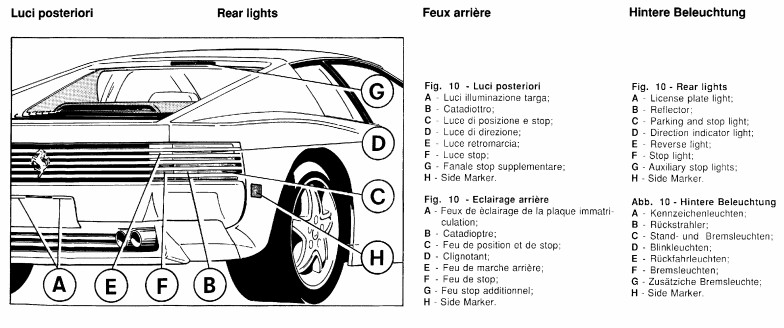
Rear Lights from the 1992 512 TR Owner’s Manual
The bulbs I cover in this post are the bulbs that go in locations: C, D, E, and F. Note that C is shown as the “Parking and stop light.” On my US Version 1992 512 TR, location C actually holds two different bulbs: one is the “stop light” (that comes on when the brakes are applied) and the other is the “parking light” which comes on comes on whenever the lights are on (in the US, we’d call that a “tail light”). On the next page of the manual (not shown), it says that both bulbs here should be replaced with the same bulb type… but that’s incorrect. I don’t know if maybe the bulb layout is different on Euro vs US versions of the 512 TR, but at least in my 1992 US version Ferrari 512 TR, the following bulbs are all installed and working great.
512 TR Rear Bulb Layout
Because the wording and images in the manual are a bit confusing, I made my own image with labels to make things easier, and will use these same terms throughout this article. The right side is shown, but naturally this layout would be “flipped” on the left side.
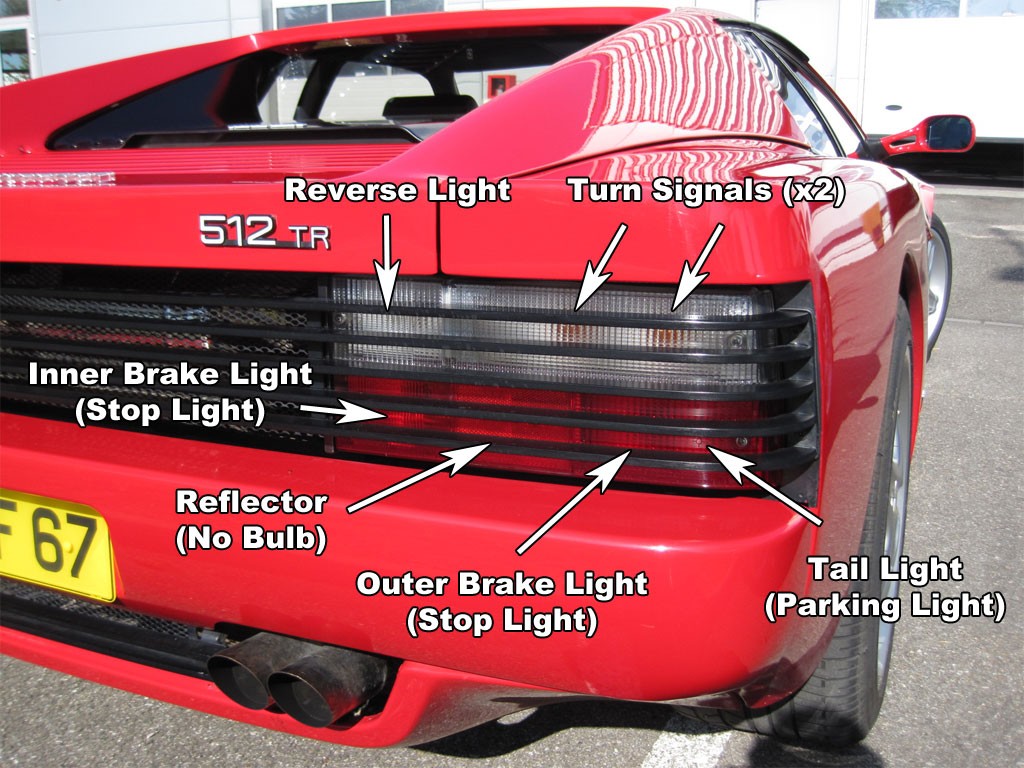
Ferrari 512 TR rear lights with labels
I’ve also included a few photos of my car as I installed and tested the bulbs. The camera on my iPhone doesn’t do a good job of showing just how much difference there is between the OEM vs. the LED bulbs (and the fact that I took these photos during the day probably doesn’t help), but I assure you the difference is massive — not only in the light output, but also the color and the ability for the bulb to completely fill the fixture. In all the included photos, the LEDs are on the right and the incandescent OEM bulbs are on the left.
LED Replacement Tail Light / Rear Parking Light Bulbs
As I mentioned above, the manual calls this Location C, but there are actually two bulbs in that location. The outer-most bulb is what I we call a “tail light” in the US (the manual calls it a “parking light”). Here they are on my car (LED version is on the right side):
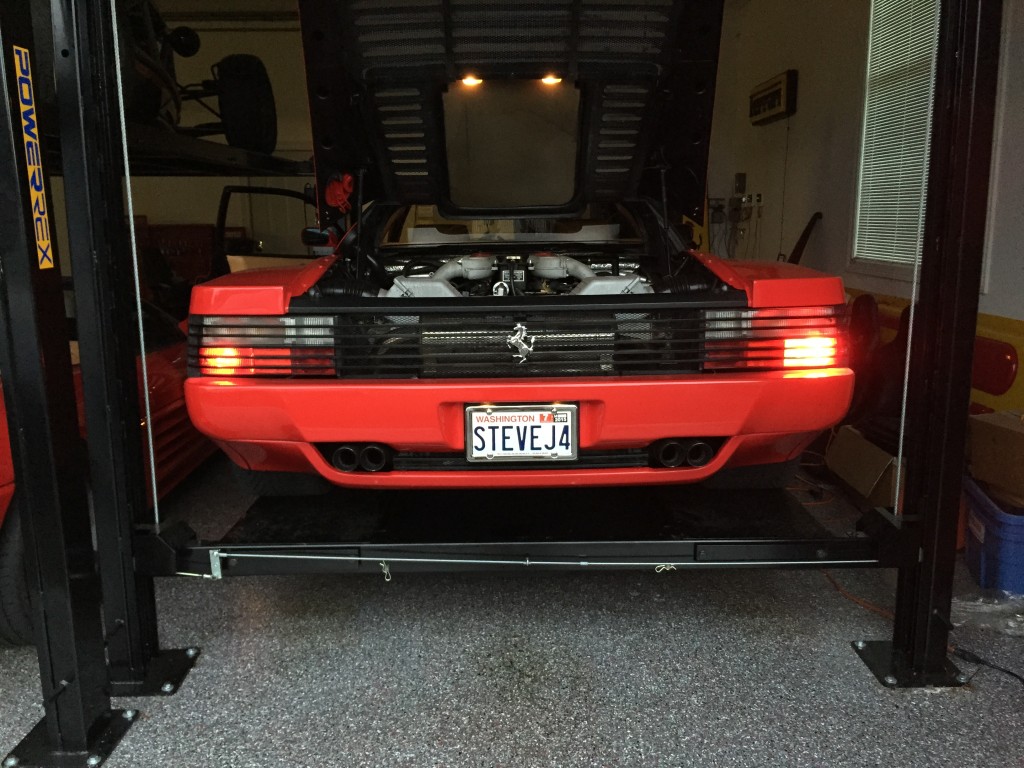
Ferrari 512 TR tail lights
OEM Bulb: The original stock bulb for this location is a Leuci R5W, white, single contact bayonet base.
LED Replacement: The manual calls for a double contact bayonet base (and dual filament) 1034-3/32 bulb — which is incorrect. This location actually needs an 1156 single contact bulb, so replace it with a red 1156 single contact LED.
Total Number of Bulbs: 2 (one on each side)
LED Replacement Rear Outer Brake Light / Stop Light Bulbs
This is the second bulb in Location C, shown as the “Outer Brake Light” in my layout photo. When the brakes are applied, these bulbs turn on, as well as the “Inner Brake Light” bulbs, as shown in this photo. The Outer Brake Lights are the bulbs just outside the reflectors.
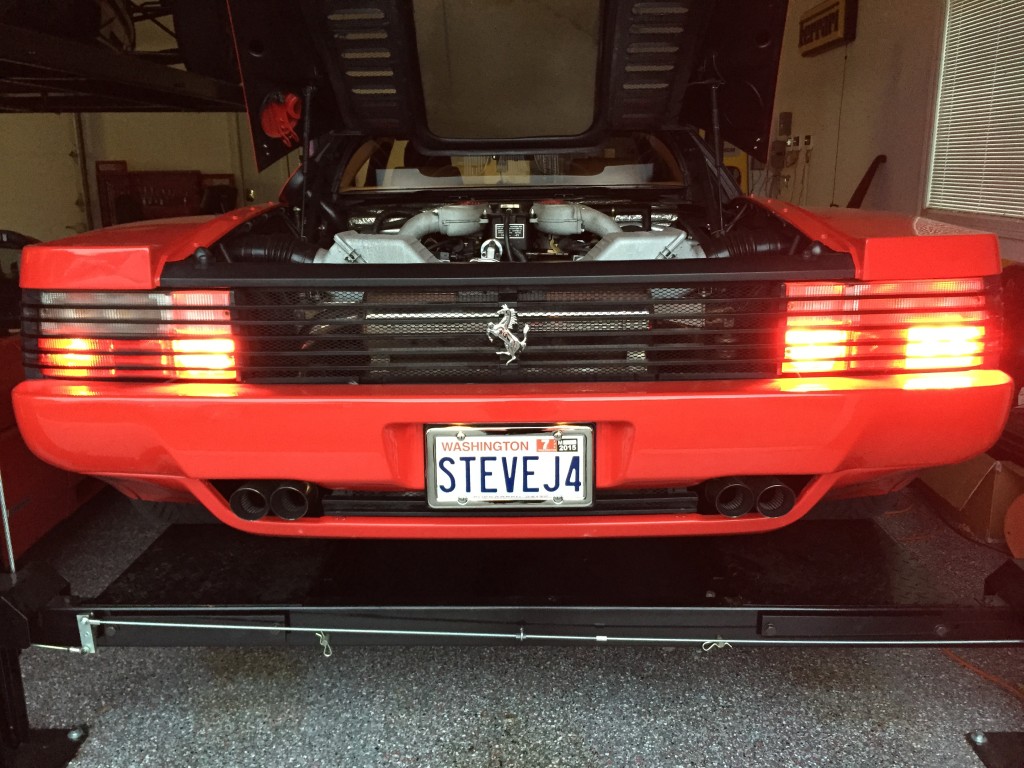
Inner and Outer Brake Lights (Stop Lights) when the brakes are applied.
OEM Bulb: The original stock bulb for this location is an OSRAM P21/5W, white, double contact bayonet base.
LED Replacement: The manual calls for “1034-3/32 cp” bulb, so the correct LED replacement is a red 1157 double contact LED.
Total Number of Bulbs: 2 (one on each side)
LED Replacement Rear Inner Brake Light / Stop Light Bulbs
Shown in the manual as “stop lights” in Location F, these inner brake light bulbs sit directly below the reverse lights and illuminate the lens on the bottom row that sit closest to the engine bay.
OEM Bulb: The original stock bulb for this location is a Leuci R5W, white, single contact bayonet base.
LED Replacement: The manual calls for “1073/32 cp” bulb, so the correct LED replacement is a red 1156 single contact LED.
Total Number of Bulbs: 2 (one on each side)
LED Replacement Reverse Light Bulbs
Shown in the manual as “reverse light” in Location E, these innermost top-row bulbs light up only when the car is in reverse. Replacing the stock bulbs with LEDs makes a huge difference when trying to back up at night. You can see a different in the LED bulb on the right side in this photo, but when it’s dark, the difference is even bigger. The light output is whiter, brighter, and is almost like having rear headlights!
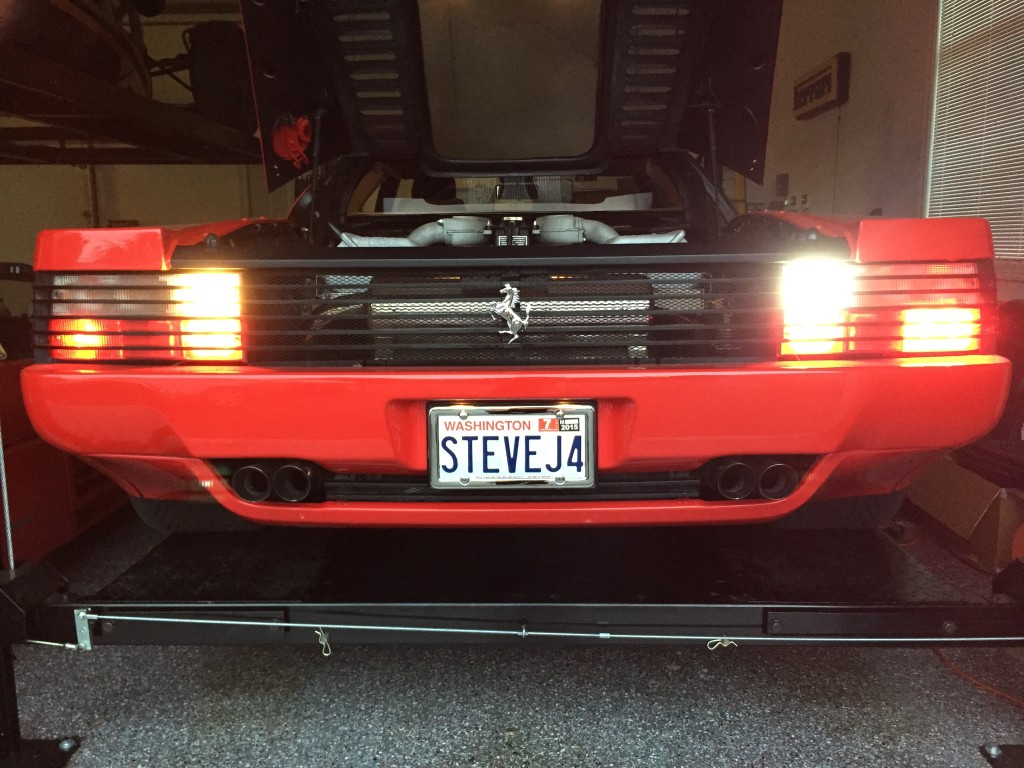
Reverse lights (top row) illuminated.
OEM Bulb: The original stock bulb for this location is a Leuci R5W, white, single contact bayonet base.
LED Replacement: The manual calls for “1073/32 cp” bulb, so the correct LED replacement is a white 1156 single contact LED.
Total Number of Bulbs: 2 (one on each side)
LED Replacement Rear Turn Signal Bulbs
Strangely, the Ferrari 512 TR manual doesn’t even mention which bulbs are needed for the rear turn signal fixtures. Each side requires two bulbs, and because they simply blink on and off, you might assume that you only need a single filament / single contact bulb… but you’d be wrong. Even though only one of the contacts in their wiring harness is used, the rear turn signals need to be dual contact bulbs.
Also, because LED bulbs require much less amperage to operate than standard bulbs, you’ll need to use a new flasher relay to make the bulbs flash at the proper speed (more on that below).
OEM Bulb: The original stock bulb for this location is an OSRAM P21/5W, amber, double contact bayonet base.
LED Replacement: The manual doesn’t mention this bulb, but the correct LED replacement is an amber 1157 double contact LED.
Total Number of Bulbs: 4 (two on each side)
LED Replacement Front Turn Signal / Parking Light Bulbs
At the front end of the 512 TR, the only bulbs worth replacing with LEDs are the turn signals. They take the same bulbss as the rear turn signal fixtures, but there’s only one per side up front. These are mentioned in the owner’s manual as “front direction indicator and parking light” as well as “front direction indicator and pilot light.” As with the rear turn signal bulbs, if you replace these with LEDs you’ll need to use a new flasher relay to make the bulbs flash at the proper speed.
OEM Bulb: The original stock bulb for this location is an OSRAM P21/5W, amber, double contact bayonet base.
LED Replacement: The manual calls for “1034-3/32 cp” bulb, so the correct LED replacement is an amber 1157 double contact LED.
Total Number of Bulbs: 2 (one on each side)
LED Replacement Side Marker Bulbs
Absent on the Euro version, the US version of the 512 TR has four side marker fixtures, one on each corner of the car. The two at the front are amber and the two at the rear are red. The stock bulbs are all white, but you’ll get better results with bulbs that match the lens colors. Also, the bulb has to be inserted with the correct polarity, so if it doesn’t work, try flipping it over and should light up.
OEM Bulb: The original stock bulb for this location is a 194 4W, white, T10 wedge contact base.
LED Replacement: The manual only calls for a “tubular 4W” bulb, but the correct LED replacement for the front markers is an amber 194 T10 LED, and red 194 T10 LED for the rears.
Total Number of Bulbs: 4 (2 amber up front, 2 red in the rear)
LED Turn Signal Flasher Relay
One of the benefits of LEDs is that they use far less energy than traditional bulbs for the same (or even brighter) light output. However, that benefit can cause trouble with the flasher relay (which is what causes your turn signals to blink). Because the LED bulb uses such low amperage, the relay is fooled into thinking that the traditional bulb has burned out, so it then speeds up the flash rate so you’ll notice the turn signal dash indicator is blinking wildly and know the bulb needs replacing.
There are two solutions to this problem. The more complex approach is to splice a resistor into each turn signal bulb’s wire, so that the flasher “sees” more resistance when the bulb is lit and blink normally. On the 512 TR, you’d need to do that six times (two turn signal bulbs up front, four in the back). A much easier solution is simply to replace the turn signal flasher relay with an updated one that will still work properly with the LED’s lower resistance. On most cars and motorbikes, this CF13 JL-02 flasher should do the trick. But on the the 512 TR, you need to replace the stock ITALAMEC 12W 66W DOT 277 relay with a CF14 JL-02 flasher, which has the positive and negative terminals in the proper positions.
The turn signal flasher relay is located inside the cabin, on the passenger side, underneath the dash. If you lie down on the floor and shine a flashlight up under the dash, you’ll see two relays secured with a 10mm nut. You’re looking for the one that says ITALAMEC on it. It looks like this:
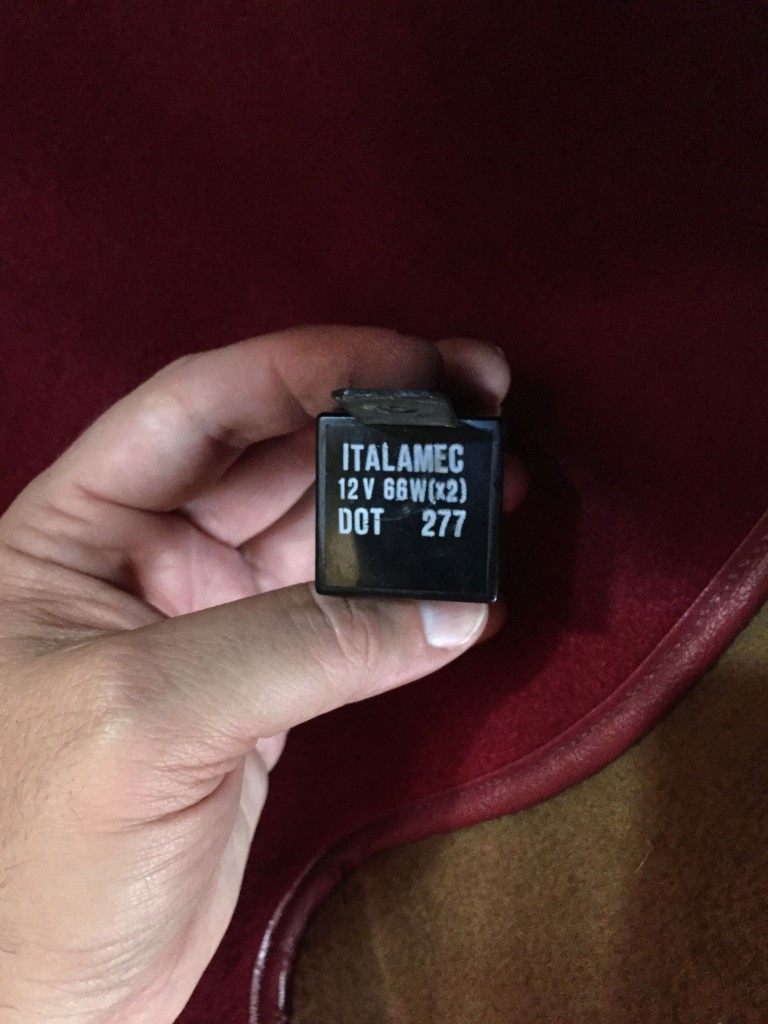
The OEM turn signal flasher relay will not work with LED bulbs.
If you accidentally unplug a relay that has more than three terminals, don’t worry. Just plug it back in and pick the other one. The correct relay only has three terminals, so its plug will look like this:
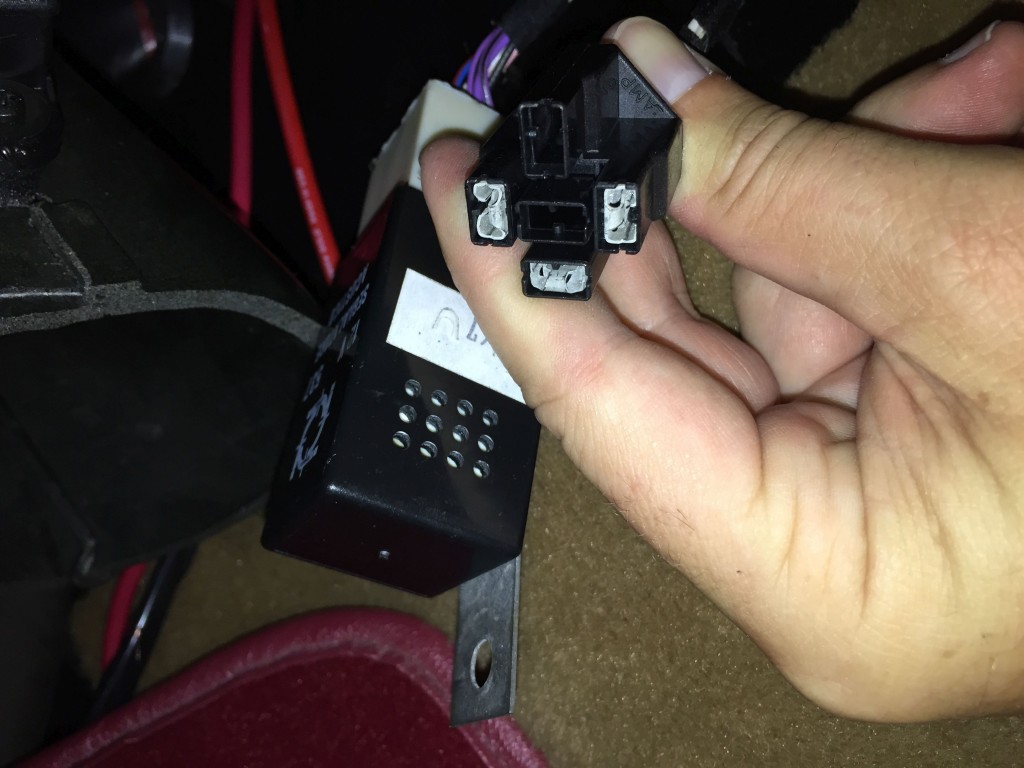
The turn signal flasher relay plug is located under the passenger side dash.
Plug the new relay in place (it may not have a screw hole to re-secure it, so zip-ties will come in handy), and test out your flashers. The easiest way to do so is with the hazard button, which uses this same relay.
Ferrari 512 TR LED Bulb Shopping List
To sum up, here’s a summary of everything you’ll need to replace all the old bulbs in a Ferrari 512 TR with LEDs:
- 4 x Red 1156 single contact LED (stop lights and tail lights)
- 2 x Red 1156 single contact LED (brake lights)
- 2 x White 1156 single contact LED (reverse lights)
- 6 x Amber 1157 double contact LED (front and rear turn signals)
- 2 x Amber 194 T10 LED (front side markers)
- 2 x Red 194 T10 LED (rear side markers)
- 1 x CF14 JL-02 turn signal flasher
As always, I welcome your questions, comments, and feedback below!
The post How To: Replace Ferrari 512 TR Bulbs with LEDs appeared first on SteveJenkins.com.